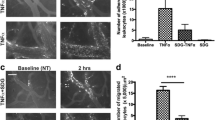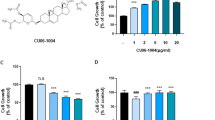Abstract
Background
The BBB plays a crucial role in the development of numerous neurological diseases and is especially vulnerable to oxidative stress. Human brain microvascular endothelial cells (HBMECs), the principal constituents of the BBB, significantly contribute to its formation and preservation. Increasing evidence indicates a potential inverse correlation between the consumption of dietary flavonoids and cardiovascular risk, which could be attributed to their antioxidative properties.
Objective
To explore the impact of four prevalent and abundant flavonoids on HBMECs within a microenvironment characterized by oxidative stress.
Results
Quercetin, apigenin, and genistein notably mitigated the adverse effects of H2O2-induced dysfunctions observed in various HBMEC events, including capillary network differentiation, growth, and survival. Moreover, these compounds reversed the oxidative stress provoked by H2O2, alongside reducing oxidative damage to lipids and DNA. Conversely, myricetin failed to reverse the H2O2-induced oxidative stress and did not exhibit any protective effects on HBMEC. Intriguingly, quercetin and apigenin elevated NRF2 and NQO1 levels in HBMEC, while genistein did not have the same effect.
Conclusions
Our research offers preclinical evidence indicating that certain flavonoids exhibit antioxidant effects, effectively reducing the dysfunction induced by oxidative stress in brain endothelial cells. This underscores the beneficial impact of flavonoids on the blood–brain barrier (BBB). Additionally, our findings propose potential strategies utilizing flavonoids for the treatment of neurological diseases.





Similar content being viewed by others
Data availability
The datasets generated during the current study are available from the corresponding author upon reasonable request.
References
Albano GD, Gagliardo RP, Montalbano AM, Profita M (2022) Overview of the mechanisms of oxidative stress: impact in inflammation of the airway diseases. Antioxidants (Basel) 11(11):2237
Alghamdi A, Almuqbil M, Alrofaidi MA, Burzangi AS, Alshamrani AA et al (2022) Potential antioxidant activity of apigenin in the obviating stress-mediated depressive symptoms of experimental mice. Molecules 27(24):9055
Bachmeier C, Mullan M, Paris D (2010) Characterization and use of human brain microvascular endothelial cells to examine beta-amyloid exchange in the blood-brain barrier. Cytotechnology 62(6):519–529
Berndt S, Issa ME, Carpentier G, Cuendet M (2018) A bivalent role of genistein in sprouting angiogenesis. Planta Med 84(9–10):653–661
Cai H (2005) Hydrogen peroxide regulation of endothelial function: origins, mechanisms, and consequences. Cardiovasc Res 68(1):26–36
Cai F, Li B, Li J, Ding Y, Xu D et al (2023) Myricetin is effective and selective in inhibiting imatinib-resistant chronic myeloid leukemia stem and differentiated cells through targeting eIF4E. Anticancer Drugs 34(5):620–626
Clemente-Soto AF, Salas-Vidal E, Milan-Pacheco C, Sanchez-Carranza JN, Peralta-Zaragoza O et al (2019) Quercetin induces G2 phase arrest and apoptosis with the activation of p53 in an E6 expression-independent manner in HPV-positive human cervical cancer-derived cells. Mol Med Rep 19(3):2097–2106
Coyle CH, Kader KN (2007) Mechanisms of H2O2-induced oxidative stress in endothelial cells exposed to physiologic shear stress. ASAIO J 53(1):17–22
Daneman R (2012) The blood-brain barrier in health and disease. Ann Neurol 72(5):648–672
Dias MC, Pinto D, Silva AMS (2021) Plant flavonoids: chemical characteristics and biological activity. Molecules 26(17):5377
Faria A, Pestana D, Teixeira D, Azevedo J, De Freitas V et al (2010) Flavonoid transport across RBE4 cells: a blood-brain barrier model. Cell Mol Biol Lett 15(2):234–241
Friedman A, Kaufer D (2015) Blood-brain barrier in health and disease. Semin Cell Dev Biol 38:1
Fu J, Zeng W, Chen M, Huang L, Li S et al (2022a) Apigenin suppresses tumor angiogenesis and growth via inhibiting HIF-1alpha expression in non-small cell lung carcinoma. Chem Biol Interact 361:109966
Galati G, O’Brien PJ (2004) Potential toxicity of flavonoids and other dietary phenolics: significance for their chemopreventive and anticancer properties. Free Radic Biol Med 37(3):287–303
Garcia YJ, Rodriguez-Malaver AJ, Penaloza N (2005) Lipid peroxidation measurement by thiobarbituric acid assay in rat cerebellar slices. J Neurosci Methods 144(1):127–135
Han Y, Zhang T, Su J, Zhao Y, Chenchen, et al (2017) Apigenin attenuates oxidative stress and neuronal apoptosis in early brain injury following subarachnoid hemorrhage. J Clin Neurosci 40:157–162
** Z, Ke J, Guo P, Wang Y, Wu H (2019) Quercetin improves blood-brain barrier dysfunction in rats with cerebral ischemia reperfusion via Wnt signaling pathway. Am J Transl Res 11(8):4683–4695
Juca MM, Cysne Filho FMS, de Almeida JC, Mesquita DDS, Barriga JRM et al (2020) Flavonoids: biological activities and therapeutic potential. Nat Prod Res 34(5):692–705
Kim GH, Kim JE, Rhie SJ, Yoon S (2015) The role of oxidative stress in neurodegenerative diseases. Exp Neurobiol 24(4):325–340
Lee YW, Lee WH (2008) Protective effects of genistein on proinflammatory pathways in human brain microvascular endothelial cells. J Nutr Biochem 19(12):819–825
Li Y, Zhang JJ, Chen RJ, Chen L, Chen S et al (2022) Genistein mitigates oxidative stress and inflammation by regulating Nrf2/HO-1 and NF-kappaB signaling pathways in hypoxic-ischemic brain damage in neonatal mice. Ann Transl Med 10(2):32
Liang HW, Qiu SF, Shen J, Sun LN, Wang JY et al (2008) Genistein attenuates oxidative stress and neuronal damage following transient global cerebral ischemia in rat hippocampus. Neurosci Lett 438(1):116–120
Liu Y, Li CL, Xu QQ, Cheng D, Liu KD et al (2021) Quercetin inhibits invasion and angiogenesis of esophageal cancer cells. Pathol Res Pract 222:153455
Mohd Sairazi NS, Sirajudeen KNS (2020) Natural products and their bioactive compounds: neuroprotective potentials against neurodegenerative diseases. Evid Based Complement Altern Med 2020:6565396
Moujahed S, Ruiz A, Hallegue D, Sakly M (2022) Quercetin alleviates styrene oxide-induced cytotoxicity in cortical neurons in vitro via modulation of oxidative stress and apoptosis. Drug Chem Toxicol 45(4):1634–1643
Orsolic N, Goluza E, Dikic D, Lisicic D, Sasilo K et al (2014) Role of flavonoids on oxidative stress and mineral contents in the retinoic acid-induced bone loss model of rat. Eur J Nutr 53(5):1217–1227
Pang Q, Zhao Y, Chen X, Zhao K, Zhai Q et al (2018) Apigenin protects the brain against ischemia/reperfusion injury via caveolin-1/VEGF in vitro and in vivo. Oxid Med Cell Longev 2018:7017204
Ramesh P, Jagadeesan R, Sekaran S, Dhanasekaran A, Vimalraj S (2021) Flavonoids: classification, function, and molecular mechanisms involved in bone remodelling. Front Endocrinol 12:779638
Ross JA, Kasum CM (2002) Dietary flavonoids: bioavailability, metabolic effects, and safety. Annu Rev Nutr 22(1):19–34
Salehi B, Venditti A, Sharifi-Rad M, Kregiel D, Sharifi-Rad J et al (2019) The therapeutic potential of apigenin. Int J Mol Sci 20(6):1305
Sena CM, Leandro A, Azul L, Seica R, Perry G (2018) Vascular oxidative stress: impact and therapeutic approaches. Front Physiol 9:1668
Shao Z, Wang B, Shi Y, **e C, Huang C et al (2021) Senolytic agent quercetin ameliorates intervertebral disc degeneration via the Nrf2/NF-kappaB axis. Osteoarthr Cartil 29(3):413–422
Sutrisno S, Aprina H, Simanungkalit HM, Andriyani A, Barlianto W et al (2018) Genistein modulates the estrogen receptor and suppresses angiogenesis and inflammation in the murine model of peritoneal endometriosis. J Tradit Complement Med 8(2):278–281
Tarozzi A (2020) Oxidative stress in neurodegenerative diseases: from preclinical studies to clinical applications. J Clin Med 9(4):1223
Valavanidis A, Vlachogianni T, Fiotakis C (2009) 8-hydroxy-2′-deoxyguanosine (8-OHdG): a critical biomarker of oxidative stress and carcinogenesis. J Environ Sci Health Part C Toxicol Carcinog 27(2):120–139
Wang H, Chen Y, Li P, Chen Y, Yu D et al (2022) Biphasic effects of statins on neuron cell functions under oxygen-glucose deprivation and normal culturing conditions via different mechanisms. Pharmacol Res Perspect 10(5):e01001
Xu D, Hu MJ, Wang YQ, Cui YL (2019) Antioxidant activities of quercetin and its complexes for medicinal application. Molecules 24(6):1123
Yamagata K, Tagawa C, Matsufuji H, Chino M (2012) Dietary apigenin regulates high glucose and hypoxic reoxygenation-induced reductions in apelin expression in human endothelial cells. J Nutr Biochem 23(8):929–936
Zhang Y, Yang Y, Yu H, Li M, Hang L et al (2020) Apigenin protects mouse retina against oxidative damage by regulating the Nrf2 pathway and autophagy. Oxid Med Cell Longev 2020:9420704
Acknowledgements
This work was supported by a research grant provided by the National Natural Science Funds of China (No. 81603095). We express our gratitude to Dr. Emily Johnson for her invaluable assistance in language editing and proofreading.
Funding
This work was supported by a research grant provided by the National Natural Science Funds of China (No. 81603095).
Author information
Authors and Affiliations
Contributions
ZLG designed and supervised the study, QT, XQY, LZC and KJ conducted the experiments, all authors analyzed and interpreted the data, QT prepared the manuscript, ZLG approved the submission.
Corresponding author
Ethics declarations
Conflict of interest
Qian Tan declares that she has no conflict of interest; **aoqiong Yan declares that she has no conflict of interest; Lizhu Chen declares that she has no conflict of interest; Kun Jiang declares that he has no conflict of interest; Zhenli Guo declares that she has no conflict of interest.
Ethical approval
This article does not involve any studies with human participants or animals performed by any of the authors.
Additional information
Publisher's Note
Springer Nature remains neutral with regard to jurisdictional claims in published maps and institutional affiliations.
Rights and permissions
Springer Nature or its licensor (e.g. a society or other partner) holds exclusive rights to this article under a publishing agreement with the author(s) or other rightsholder(s); author self-archiving of the accepted manuscript version of this article is solely governed by the terms of such publishing agreement and applicable law.
About this article
Cite this article
Tan, Q., Yan, X., Chen, L. et al. Dietary flavonoids protect human brain microvascular endothelial cell from oxidative stress-induced dysfunction. Mol. Cell. Toxicol. (2024). https://doi.org/10.1007/s13273-024-00461-7
Accepted:
Published:
DOI: https://doi.org/10.1007/s13273-024-00461-7




